Mark Morris Dance Group / James and Martha Duffy Performance Space, Mark Morris Dance Center, Brooklyn, NY / March 17-27, 2011
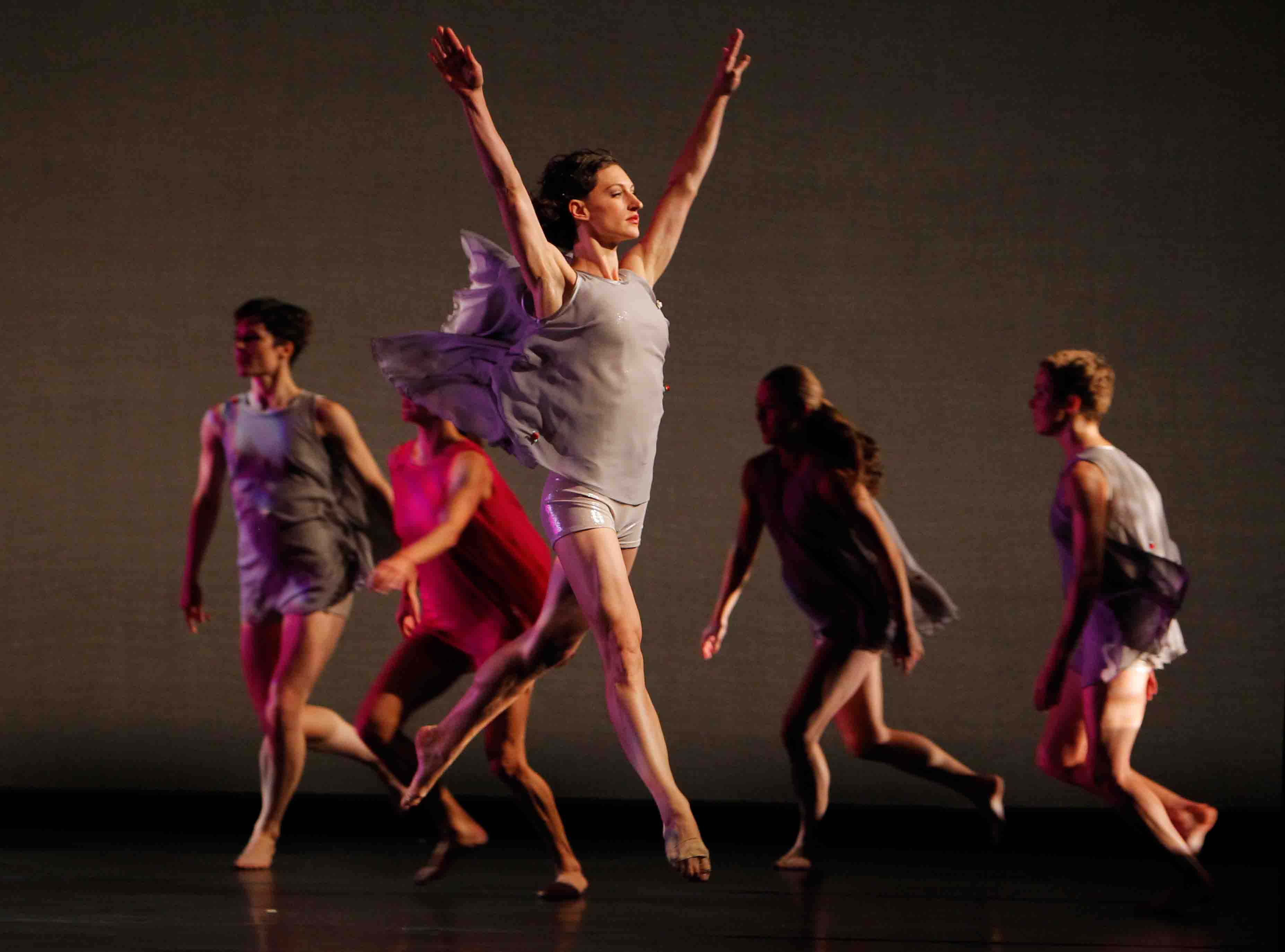
There Is Nothing Like a Dame: Amber Star Merkens (c.) and women of the Mark Morris Dance Group in Morris’s Petrichor
Photo: Brian Snyder
Where does Mark Morris make his artistic home in New York? At the David H. Koch Theater? It has showcased L’Allegro, il Penseroso ed il Moderato, often cited as his masterpiece, no fewer than four times and housed the premiere and a return run of his Mozart Dances. At the Brooklyn Academy of Music? It has been inviting him back since 1984, before his name became a household word. Actually, his key home may lie in the building cater-corner to BAM, the Mark Morris Dance Center, which he built for his work and his company’s, and for significant auxiliary activities, one being a school that offers classes in myriad kinds of dance (an echo of his own training) to both children and adults.
A key element of the Center is the James and Martha Duffy Performance Space, a large studio that, when filled with sleek utilitarian chairs on risers, becomes a theater. It’s a perfect venue for dances that are best seen close-to, in an intimate space. It’s here that the Mark Morris Dance Group just presented a program of three dances new to New York: Festival Dance (in its world premiere), Petrichor, and The Muir.
By audience acclamation, Festival Dance was the program’s huge hit. A few of my colleagues pointed out that, while exhilarating to them as well as to the general audience, the piece was not in a class with Morris masterworks like L’Allegro and Dido and Aeneas. I agree with them, and have engaged in that bell-curve style of criticism often enough. But this dance, so deftly made and so thrilling–joy personified–made me reconsider. On occasion it might be better to avoid diminishing wonderful dances by rating them against the ones, sometimes by the selfsame dance maker, that will make it into the history books.
Despite the tumult and despair currently plaguing the world, Festival Dance insists that delight and exuberance still exist. It’s set to Johann Nepomuk Hummel’s Piano Trio No. 5 in E Major; the other two instruments are cello and violin. (Between the ages of eight and ten, Hummel took his piano lessons from Mozart, free of charge, room and board included.)
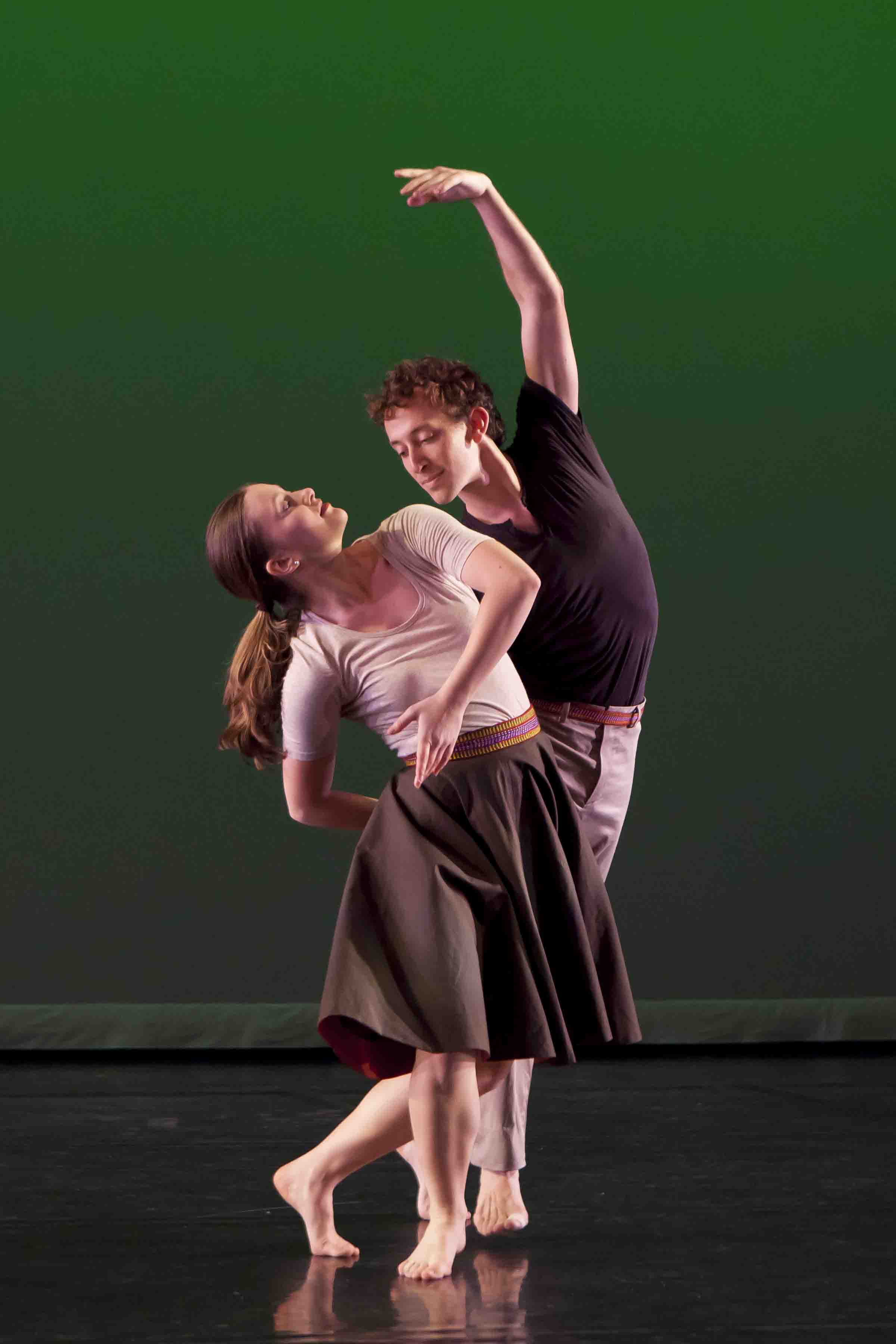
Love Me Forever: Rita Donahue and Aaron Loux in Morris’s Festival Dance
Photo: Richard Termine
The dance is populated by a dozen people chosen from Morris’s crew, both veterans and newbies. We meet them as couples, beginning with the honeyed Rita Donohue and Aaron Loux. These two, who are apparently very much in love (he especially) are capable of playing in a childlike way, always on the verge of laughter. Their relationship remains light; they might be teenagers.
As more dancers join in and several other couples come to the fore, Michelle Yard and Domingo Estrada reveal a love that’s deeper, richer, more serious. It is both grave and sensuous. This coupling suggests that both artists, striking on their own, have found a partner who makes their individual qualities more resonant.
Next the dance demonstrates how two lines of five–one all-male, one all-female to begin with–can interweave, reshuffle, and regroup in unexpected ways. This sounds like a dry cerebral exercise that might be thought up by an idiot savant. Thanks to Morris’s uncanny skill in fusing form with feeling, it’s anything but. The configurations say something, several things, and one of them is that where you are in the matrix of life can change–by accident or fate–at any minute.
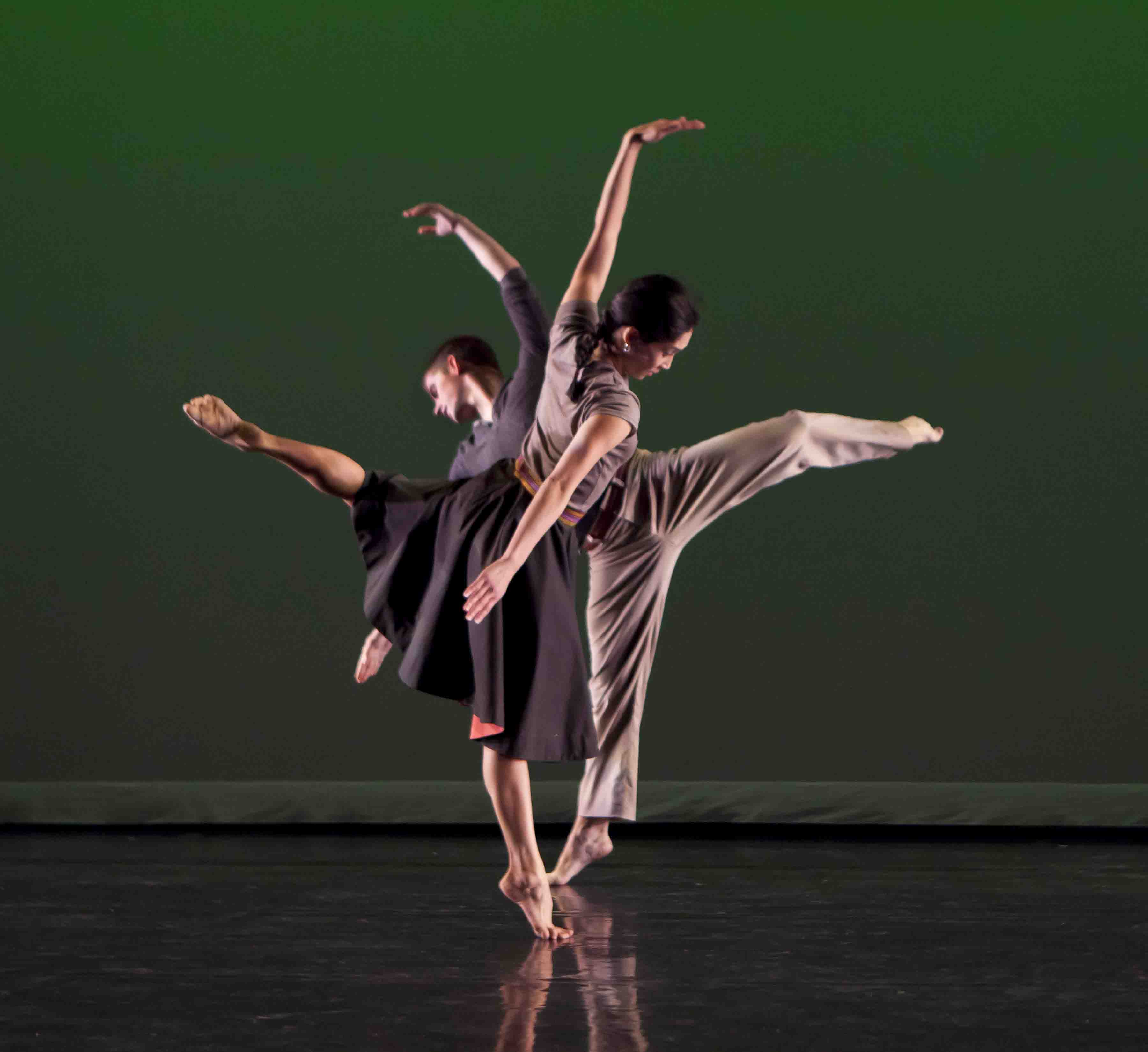
Crossing Paths: Maile Okamura and Spencer Ramirez in Festival Dance
Photo: Richard Termine
Finally the dance grows more and more wild. Like Balanchine, Morris revels in exorbitant energy, kept under control–just–by the shapes he gives it. The piece closes with the youthful embrace that served as its opening statement. Why? That’s left to the spectator to ruminate on.
According to the Oxford English Dictionary, “petrichor” is “a pleasant, distinctive smell frequently accompanying the first rain after a long period of warm, dry weather in certain regions.” To me the word would make a fine name (and recipe) for a perfume. (MMDG’s marketing department might work wonders with this.)
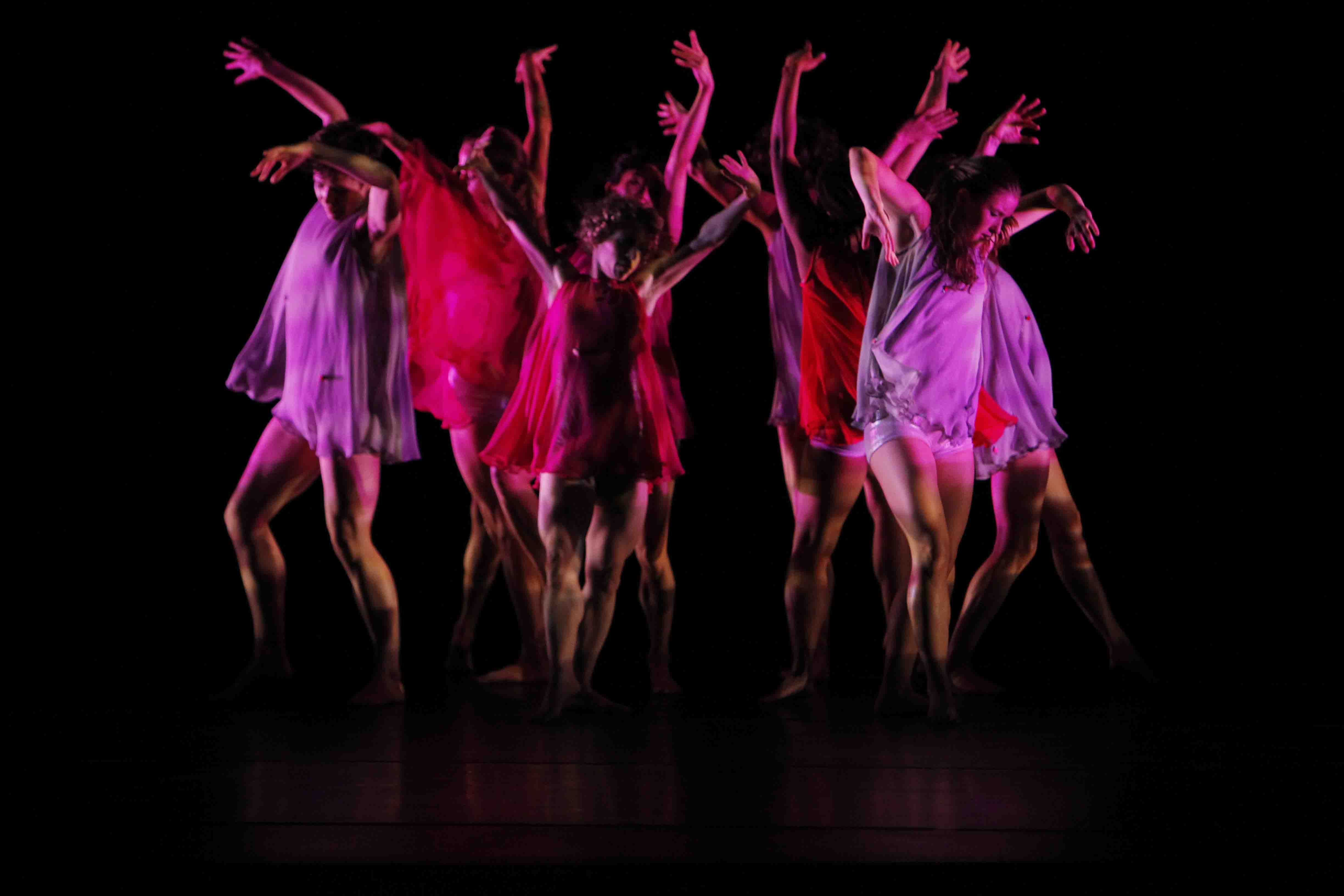
“Where All the Women Are Strong”: The women of the Mark Morris Dance Group in Petrichor
Photo: Brian Snyder
Calling a new work Petrichor simply because the word appealed to his fancy, Morris created a deliquescent dance for the eight seasoned women in his troupe. The choreography is beautifully in thrall to his chosen music–Heitor Villa-Lobos’s String Quartet No. 2, Op. 56. The score reflects the qualities of Debussy and Ravel, and Morris accordingly sends his octet of nymphs rushing and interweaving through their secret haunt, which is actually empty space.
Needless to say, this choreographer’s nymphs-in Elizabeth Kurtzman’s red, pink, tangerine, or gray tunics overlaying pearly bike shorts–are quite contemporary. When the women move with allegro fervor, their brief loose tunics whip crosswise or fly up and the skin-tight, gleaming shorts emphasize the power of their buttocks. When the nymphs are becalmed, one can study the marvelous workings of their bare legs and feet. Overall, though, the most memorable impression the piece gives is one of fluidity–of a lake, let’s say, rippled by wind.
Certain specific moves and gestures in the piece reinforce its connection to mythic times. The repeated thrumming of the feet on the floor suggests primal ritual, and the recurrent cupping of the hands against an ear remind us of Romantic ballet’s references to idylls of the past in its supernatural sylphs and wilis.
Petrichor is remarkable for the enormous variety Morris can derive from conventional choreographic tropes: the line-up or circle–and their breaking down into smaller groups that repeat the pattern; dancing in unison; dancing in canon; crisscrossing and meshing lines; movement traveling down a line; lines that peel off; pairs working as mirror images. Morris makes these familiar ploys interesting all over again–and inventively complex, without ever blurring.
Toward the end of the piece, the women make birds’ wings out of their arms as they run, as if to warn us that they–like dance itself–will disappear. Then the whole group keeps retreating from view and returning, retreating and returning, until you wonder if you’re seeing them at all or, perhaps, dreaming them.
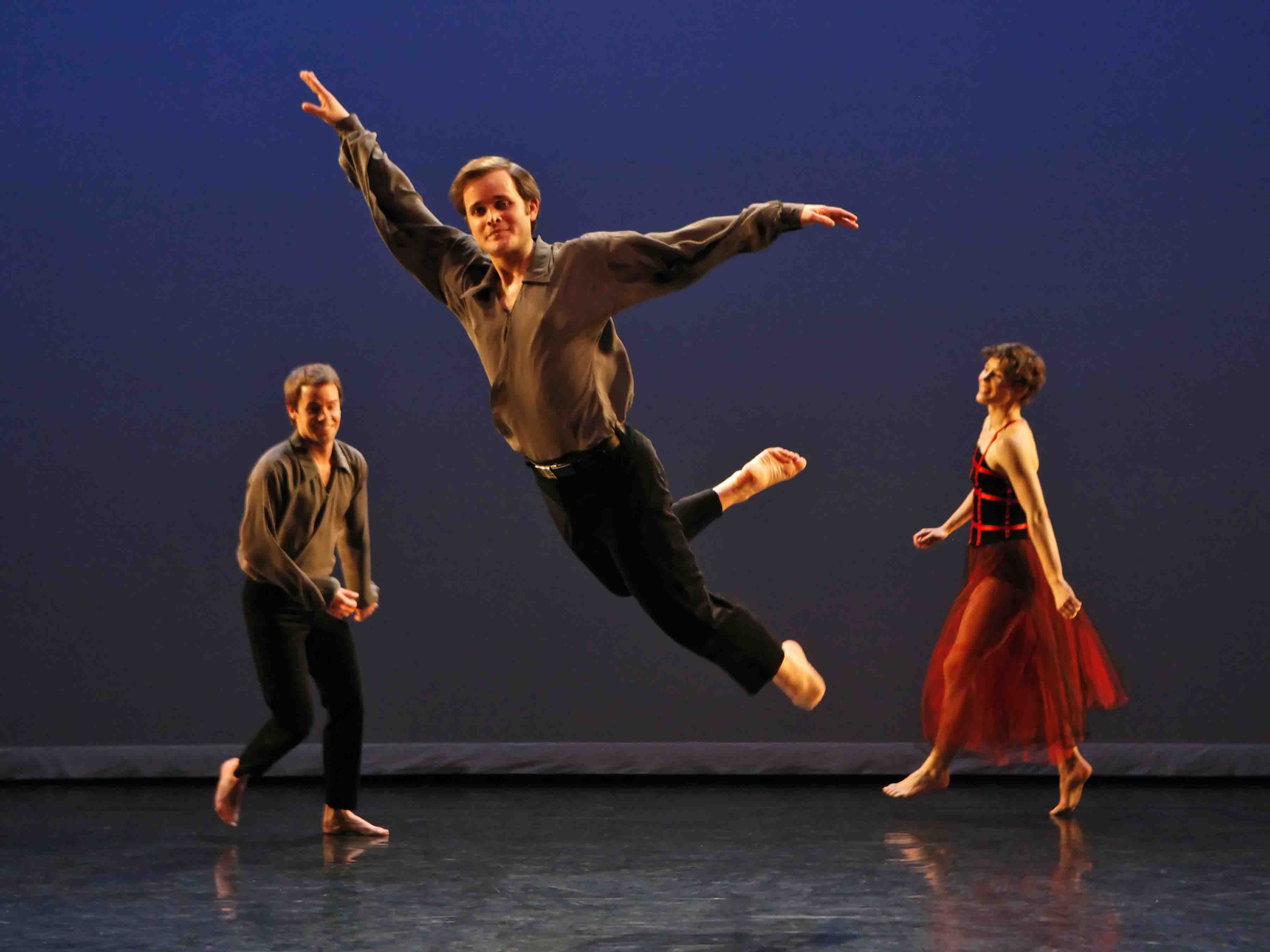
Belle of the Block: Laurel Lynch (r.) with suitors Dallas McMurray (c.) and Noah Vinson (l.) in Morris’s The Muir
Photo: Richard Termine
While The Muir was the weakest item on the program, it could be the prize example of a lesser choreographer’s work. The sheer intelligence of its stagecraft makes it worthwhile. And its score, Beethoven’s setting of Scottish and Irish songs–romantic (in several modes), nostalgically linked with nature, high-spirited, or plaintive–does more than half the work of expressing Morris’s dual motif of love and death. The title of the dance refers to the Highlanders–sons and fathers, lovers and those beloved–who were slaughtered at Drumossie Muir, making a last stand against the English in the 1746 Battle of Culloden. Robbed of their lives, they left their womenfolk to mourn.
Although the structure of the piece is episodic, The Muir adds up to a firm personal conviction that Morris often states in his choreography: Life is richest and most meaningful when people bond in small colonies–call them clans, if you will. The dance also shows–once again, to be sure–Morris’s understanding of love as a tremendously variegated experience. The lyrics of the songs, well articulated by Irene Snyder, John Matthew Myers, and Jorell Williams, speak of desire, flirtation, and rivalry; of passion fulfilled, passion rejected, and passion spent; and of course, of love conquered by death.
As he often does, Morris incorporates a number of mimed gestures that are repeated at intervals. One has the dancer emphatically touching his heart and then the center of his back. Its meaning is unusually opaque. I translated it bluntly as “The moment you love, you’re sure to be stabbed in the back.”
Although the six dancers of the piece gave it their all, when I set sail for my desert island, there’s just one vignette from The Muir that I’m taking with me. It’s choreographed to the song about the irresistible Sally; you know the refrain: “She is the darling of my heart and she lives in our alley.”
Laurel Lynch, who hit her artistic stride, blazingly, this season, makes an unforgettable Sally. Dressed in a Romantic-era tutu tinted rosy red, she runs through imaginary narrow backstreet passages, casting glances of teasing gaiety behind her, but far too busy to stop. You adore her on the instant–for her vitality, her wit, and, not least, because she seems to leave a perfume in her wake. One local admirer, played as a sweet, devoted, but unprepossessing fellow by Dallas McMurray, is also enraptured. The poor lad sees his small claim to this vision’s attention dwindle even further when he discovers he has a rival, who may even have gotten there first.
According to Morris’s usual policy, the music for the entire program was played live by a fine chamber group of instrumentalists and singers tucked into in a corner inches from the stage. On one of the two nights I saw the show, I could read the score over the shoulder of one of the violinists. From that position I could also see into the wings and admire the dancers’ composure when they were officially out of sight and the alertness that suffused them as they were about to step onto the stage. I’ve seen many kinds of dancing in all sorts of venues. This experience felt strangely like being at home.
© 2011 Tobi Tobias




Hi Tobi,
I agree completely with this point in your Morris piece:
“But this dance, so deftly made and so thrilling–joy personified–made me reconsider. On occasion it might be better to avoid diminishing wonderful dances by rating them against the ones, sometimes by the selfsame dance maker, that will make it into the history books.”
. . . And also love when you look at the score at the end. Nice!
Mark Morris’s physical home may well be in Brooklyn, but his spiritual home, I would posit (because I like the word posit), is his native Pacific Northwest, else why would he make a dance that has anything at all to do with rain? [See the definition of “petrichor.” –Ed.] I love this review, Tobi, for its thoughtfulness and honesty and what it says about critical integrity as well as the work itself. Thank you.
I just don’t, and never have “gotten” Mark Morris. I have never seen one dance of his I like, do not find him the musical genius others do (have they ever seen Eliot Feld’s old works?), and even though one of my favorite students of all time is still dancing with Morris, I just cannot sit through a whole evening of his “stuff.” I am not even curious enough to be taken down some path and be educated. Sorry, Mark.
I did not see this performance, and I generally agree with Penny Frank’s Comment [Just below. — Ed.] that Mark Morris is often pretentious and overwrought. Nonetheless, I did like the choreography he did for the Met’s “Nixon in China.” He made the ballet an integral part of the opera, which it had never been before, pushing the plot along. I’m intrigued, too, by the idea of seeing Morris’s work in a small, intimate space where the music and the dancing are really in your face. I’ve only seen his company in large spaces such as the BAM Opera House.
Now I will have to reconsider Morris, given this wonderfully written and thoughtful review. It’s true that the music is always live and beautifully performed, while the dancing is generally excellent, so I will make sure to see his next New York performance and re-read this review before I go. I am sure I will emerge with a whole new understanding — and perhaps even appreciation — of Morris’s choreography.
Mark Morris was his usual charming and obstreperous self at a Princeton University-staged “chat” before his company performed at McCarter Theatre tonight, revealing that he made “Petrichor” on the eight women because the company had taken on a new cadre of men who were busy learning the rep.
The program, in addition to “Petrichor” and “Festival” (both huge hits here), included “Grand Duo,” which seemed vaguely familiar to me. Then I realized Tina Fehlandt had taught it to the Princeton University dance students last year. All that unison, all that frenetic hand movement is well suited to student amateurs. It was slated to end the program but I was so glad that, instead, McCarter switched to “Festival” as the closer. You described it beautifully, and it brought the deserved standing applause.